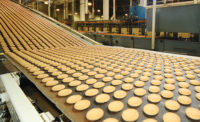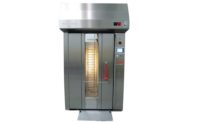Improving plant efficiency with new ovens and fryers

courtesy of Katie McLean Visuals

courtesy of Dunbar Systems Inc.

courtesy of Moline Machinery LLC

courtesy of Heat and Control Inc.

courtesy of Heat and Control Inc.

courtesy of FOODesign

courtesy of Hinds-Bock Corp.







Product line expansions, facility consolidations and the constant need to reduce operating costs are finally prompting more bakers and snack manufacturers to make long-delayed capital expenditures, especially in the area of crucial equipment like ovens, proofers and fryers.
Oven efficiency
“The baker today is looking for new dependable, state-of-the-art equipment,” says Jim Diver, director of sales, Dunbar Systems Inc., Lemont, IL. “They are looking at what can be done to reduce breakdowns on the line, reduce their labor costs, increase throughput and enjoy the benefits of today’s technology and production reporting systems.” He adds that some manufacturers are also buying bigger, more-productive lines as they close smaller, less-productive plants and consolidate them into large-capacity facilities.
Adding a new baking system to any facility poses some challenges. “The major issue is space required for the new system while staying in production, even if the existing oven is to be replaced with the new, larger oven,” Diver explains. “Auto-Bake systems requiring minimal space can be installed in a small space next to the existing oven, or in another area of the bakery, maintaining production while the installation is occurring.” Then once the new system is installed and operational, the old line can be removed or replaced with a second system.
The Auto-Bake Serpentine Baking System uses the height of a room to minimize space requirements. By using the cube of the bakery, says Diver, large ovens can be installed in a minimal space. Proofers, atmospheric coolers, refrigerated coolers and de-panning stations are elevated to allow for smaller system footprints.
Available with thermal oil, direct gas-fired (DGF) or electric heating, Auto-Bake systems offer bakers numerous other benefits, says Diver. They consume 30 percent less energy than conventional tunnel ovens; incorporate safety features such as expanded metal guards and interlocking oven doors; and are designed and constructed for easy cleaning and maintenance.
Jeff McLean, sales manager—North America, Spooner Vicars Bakery Systems, Cumming, GA, a brand of Stewart Systems Baking LLC, also cites space as the biggest challenge for manufacturers when replacing or adding a new line. “We work with customers to help them lay out a workable solution, taking into account the logistics of getting the new system into their existing facility,” he says.
Many of these customers are investing in new systems with wider ovens to increase production efficiency, and in hybrid ovens to reduce energy usage and have better control over the final product. “Hybrid ovens are what most people are using nowadays,” says McLean. “It’s a combination of direct gas-fired and direct forced-convection (DFC).”
The type of baked good being produced typically determines the type of oven needed. “A saltine or soda cracker can all be done on a DGF oven,” McLean explains. “A lot of people now are putting a DFC oven in the last zone, primarily for moisture content and color. You can’t do soda crackers 100 percent in a DFC oven. Most crackers—most of which are laminated—need the super heat of a DGF, primarily for development. To get laminated dough to rise properly and get that crack in it, you need the high heat that you get from a DGF. So a DGF is typically in the front zones of a hybrid oven, the middle portion is the cooking portion, and in the back end, you’re controlling moisture content and color with a DFC.”
Softer crackers, on the other hand, call for oven lines with more DFC sections, says McLean, while soft and rotary-molded cookies can be produced almost entirely with DFC ovens. “Most of the hybrid oven users out there want to have the flexibility to do crackers, but they also want to be able to make cookies,” he says. “In that case, we put a smaller, more-restrictive DFC zone at the end of the system, which still gives them about a 20 percent energy savings—for just that one section.”
Some of the other benefits offered by Spooner Vicars hybrid ovens include easy access for sanitation, reduced maintenance and lower maintenance costs.
Flexible fryers
The new Libra Dual Fuel Fryer from Moline Machinery LLC, Duluth, MN, to be introduced this month at iba in Münich, was developed to help bakers reduce their operating costs and improve production performance, says David Moline, sales and marketing manager.
“Gas rates in North America are far cheaper than electric rates,” says Moline. “That’s just a fact.” The fryer allows manufacturers to run on gas or electric, with the ability to optimize how it utilizes the gas and electric based on utility rates. He adds that bakeries that don’t have the necessary utilities or that are required to use gas for their fryers will find that the fryer offers them “a good balance,” too.
While running the fryer on gas can help producers cut their operating costs, electricity offers them a consistent heating medium that delivers the best performance, says Moline. “Gas fryers in the very large sizes will always have a temperature difference across the width of the fryer,” he explains. “Electric will never have a difference. The oil temperature is the same left to right, front to back, all the time, no matter what. The gas-electric combination allows you to operate the fryer while maximizing the least-expensive utility and still get the performance of an electric fryer.”
While bringing a new fryer into an existing facility doesn’t pose any particular challenges for bakers, according to Moline, issues can arise when they want to increase production, a common reason for replacing an old fryer. “In order to keep the cost per unit down, you need to make as many pieces of product as you can in a short period of time,” he says, “so you need to start with the fryer to establish your production rate. That has a ripple effect both upstream to the proofer, sheeting equipment or cake dough depositor, and downstream to your finishing, cooling and packaging equipment. As a result, you might have to make other investments in either direction along the line.”
All Libra series fryers—including the Libra Dual Fuel model—are designed for continuous sediment removal and oil filtration. Used in conjunction, these two features promote frying oil quality and decrease the need for cleaning, Moline adds.
Don Giles, director of sales for snack processing systems, Heat and Control Inc., Hayward, CA, also cites growing product lines and production requirements as reasons why processors purchase new fryers. When such situations arise, he notes that customers sometimes ask the company to modify their existing fryer, usually to increase production capacity.
Situating a new fryer into available floor space and with little or no production interruptions are priorities for manufacturers, says Giles. “We custom-engineer each fryer and have the experience to always deliver the rated capacity and highest product quality.”
Heat and Control offers several fryers capable of meeting production needs. Designed to produce 500 finished pounds per hour or more of kettle-style potato chips, the MasterTherm Kettle Fryer features uniform heating using thermal fluid, continuous fines removal and an enclosed cooking area with automatic control of temperature, oil level, slice agitation, batch loading and unloading.
The Heat and Control Unitized Vacuum Fryer fries chips made from potatoes, apples, yams and high-sugar products with no browning. It operates at 10 percent or less of normal atmospheric pressure, so product moisture boils off at a lower temperature, which helps control acrylamide. Using no external vacuum chamber, the fryer requires less floor space and energy than comparable traditional vacuum fryers.
The Heat and Control Universal Product Cooker is a tandem arrangement of three or more small fryer systems, each with its own heat exchanger, filter and oil circulation system. In addition to almost infinite adjustability of oil temperature profiles, product agitation and dwell time is individually adjustable in each fryer section. This allows the system to fry everything from kettle-style chips to traditional, continuous-fried potato chips with no slice washing. It can also fry chips made from grain, sweet potato, taro root and other ingredients, plus certain types of pellet and extruded snacks.
Basically one section of the Universal Product Cooker, the Dynamic Action Fryer is a continuous unit that can cook a variety of chips and snacks, including corn, tortilla, plantain and multigrain chips, and select pellet and extruded snacks. Safe external heating automatically maintains the optimal oil temperature and adjusts quickly to changes in product load.
Consumer demand for healthy snacks with authentic taste profiles is spurring rapid growth in batch-cooked chips, prompting many snack producers to add batch-fried chips to their product portfolio and invest in new processing lines to produce them, says Tim Reardon, group solutions manager, processing, FOODesign, Portland, OR, a tna company. “The specific frying process ensures that they retain that ‘homemade-quality’ impression, while delivering the taste and crunchiness consumers expect from their chips,” he says. “They are also surprisingly low in fat compared to standard chips, helping manufacturers to appeal to the global trend for healthy snacking.”
Introduced to the global market earlier this year, FOODesign’s batch-pro 12 batch fryer cooks vegetable products, including root vegetables like potato, carrot, taro, beet and parsnip chips. It also enables snack manufacturers to realize “significant” oil savings through an enhanced oil filtration system that extends oil life, says Reardon. “The majority of fryers require 100 percent disposal of the oil bath each week,” he explains. “With oil costs sometimes exceeding 70 cents per pound, oil bath net replacement costs can be thousands per week. As such, the elimination of this cost is a substantial benefit factor for many of our customers.”
The batch-pro 12 uses a stainless steel belt to gently sweep particles from the fryer pan bottom to prevent accumulation. The belt discharges into an auger that transfers the debris to the hot oil pump intake. From there, the particles are removed by a three-stage, hot oil filtration system, which can stabilize the quality of the frying oil after only a few hours of operation, quickly reducing the levels of free fatty acids and total polar compounds to ensure excellent product taste and bite characteristics.
The batch-pro 12 also has a hygienic design that makes it easy for operators to access, remove and replace major mechanical components for minimal plant downtime and uninterrupted production flow. In addition, the complete burner system typically delivers “80–85 percent efficiency, saving tens of thousands of dollars per year in natural gas, not to mention reducing the impact on the environment,” Reardon says.
As for installation challenges, Reardon says any new equipment requires engineering and project management to ensure the new system communicates effectively with existing equipment and is set up to meet the exact specifications of the manufacturer. “The batch-pro 12 often replaces two or more existing fryers due to its high capacity and efficient design,” he notes. “As a result, a lot of manufacturers are able to save valuable floor space by replacing an existing fryer with the batch-pro 12.”
The batch-pro 12 is also suitable for producers that want to increase the capacity of their existing lines or modernize their processes. “They often come to the realization that the low-cost fryer they bought years ago is costing them thousands of dollars in operational costs,” says Reardon. “By purchasing a system with such an incredible gas burner efficiency and heat utilization, snack producers can easily increase their profit margins over the long-term.”
Griddle depositors go servo
Through the years, two of the biggest requests from industrial bakeries involve real estate on the floor—a machine’s footprint and how can to minimize it—and reducing the cost of ownership in consumable items, says Mark Young, Southeast sales director, Hinds-Bock Corp., Bothell, WA. These machines in question can include a variety of piston and servo depositing and filling equipment, including griddle depositors typically used to produce pancakes and waffles of various sizes.
“Traditionally, those machines have been volumetric piston depositors,” Young explains. “In recent years, we started using a servo-actuated positive displacement pump, which we then manifold from one inlet to multiple discharge points. We’re then able to manifold up to 20 deposit locations from one pump.” This increases the depositors’ efficiency, lowers air consumption and lowers cost of ownership in terms of wear components and replacement parts, he says.
Manifolded servo pump depositors also can use up 50–60 percent less floor space than traditional piston-filling applications, says Young, enabling producers to add another depositor onto the floor, or add more upstream or downstream equipment.
In addition, because there are no wear items in the metering portion of a griddle depositor with a servo pump filler, the machine is ideal for high-use scenarios, says Young, unlike traditional piston depositors with O rings, which need to be relubricated and, thus, require an operator to break down the machine. It’s also easy to clean and can be clean-in-place sanitized, which further reduces downtime.
Hinds-Bock’s griddle depositors with servo-activated pumps are recipe-driven through a human-machine interface (HMI) that holds more than 30 recipes and can be easily operated by one person.
“We’re seeing the industry change to more portion-controlled items,” says Young. “That’s driving equipment purchases because once producers factor in the reduction of consumables, wear items, efficiency gains and so on, it really starts to point to the need for a new machine that will help them add or refine a product line rather than trying to retrofit existing equipment that is still of an inefficient design.”
Looking for a reprint of this article?
From high-res PDFs to custom plaques, order your copy today!














